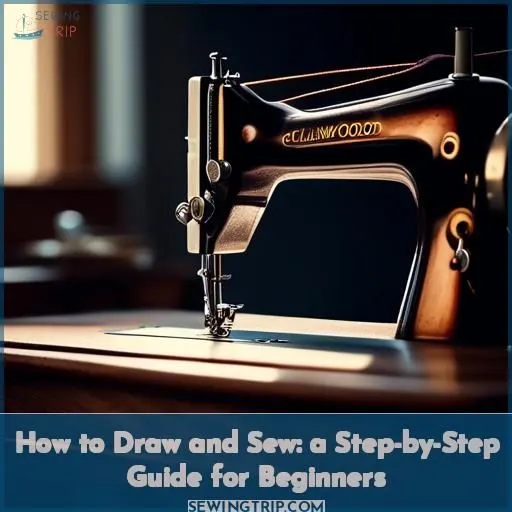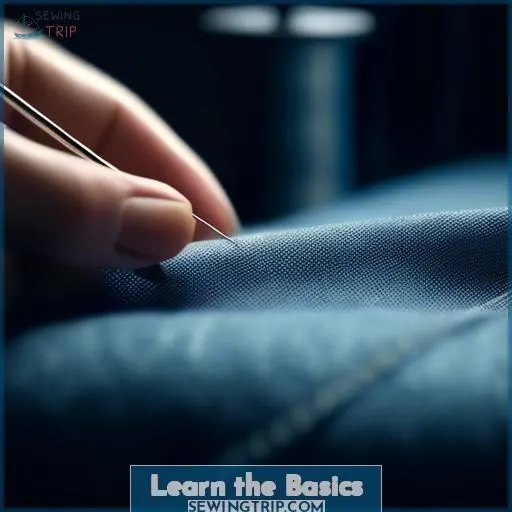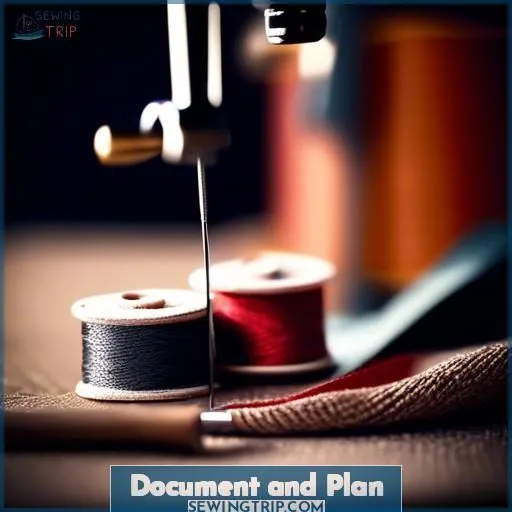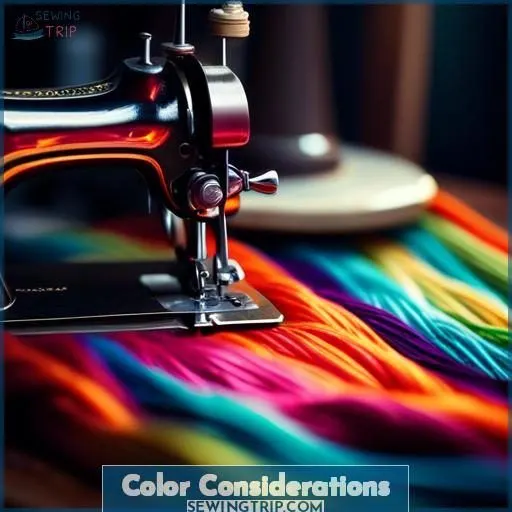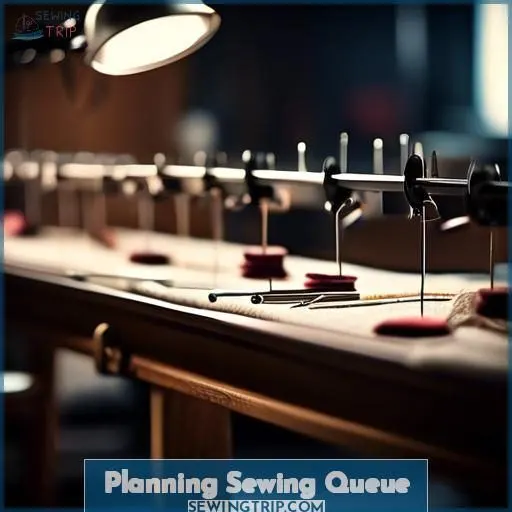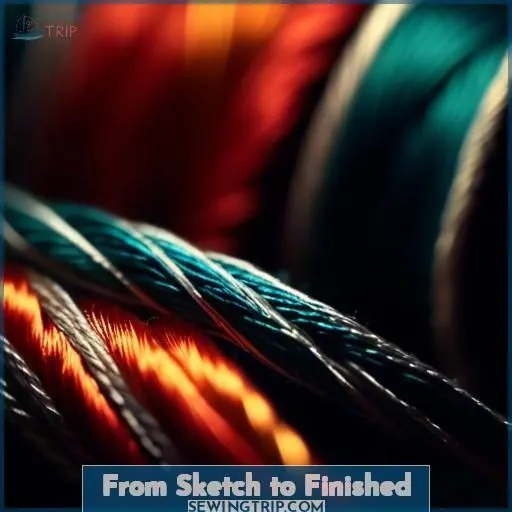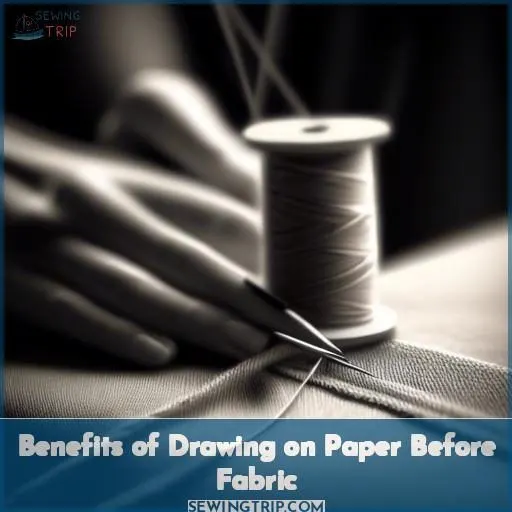This site is supported by our readers. We may earn a commission, at no cost to you, if you purchase through links.
To draw and sew, you’ll master transforming sketches into wearable garments**.
First, understand math and think critically – begin with basic blocks and existing patterns, practicing patience and precision.
Document projects to track achievements, using a notebook to transfer croquis and draw makes.
Prefer black and white sketches focusing on silhouette over color, attaching fabric swatches.
Draw before sewing, testing patterns on croquis to identify your preferred silhouette for garment types like wrap dresses.
You’ll discover favorite styles like fitted jackets, cigarette pants, and floaty blouses.
Post sketches for positive feedback, refining skills with each make – the design possibilities become endless.
Table Of Contents
Key Takeaways
- Start with basic blocks and existing patterns, practicing patience and precision.
- Document projects to track achievements, using a notebook to transfer croquis and draw makes.
- Prefer black and white sketches focusing on silhouette over color, attaching fabric swatches to sketches.
- Learn the basics of pattern drafting, understanding math and critical thinking skills, and enhancing problem-solving abilities.
How to Draw a Sew?
To draw a sew, start by sketching the outline of your design on paper, then transfer it onto fabric and use a sewing machine to stitch along the lines. This process combines drawing and sewing skills to create intricate fabric artwork.
Learn the Basics
To master the art of drawing and sewing, you’ll need a solid grasp of math and critical thinking skills. Start by familiarizing yourself with basic pattern blocks and existing designs, and don’t forget to practice patience and precision throughout the process.
Understand Math and Critical Thinking Skills
Diving into pattern drafting? Get ready! It’s where math meets design, demanding precision and critical thinking skills. Think of it as solving a puzzle where every piece is essential. Enhance those problem-solving abilities and let’s create magic.
Begin With Basic Blocks and Existing Patterns
To embark on your patternmaking adventure, it’s imperative to grasp the fundamentals. Commence by delving into mathematics and analytical thinking skills, as they’re indispensable for patternmaking. It’s necessary to comprehend seam allowances, pattern blocks, and fabric manipulation techniques. Basic blocks and extant patterns can serve as the cornerstone of your designs. You can utilize these patterns to forge your own distinctive designs or tailor them to suit your personal aesthetic.
To initiate the process, you’ll require certain essential tools. These include pattern weights, pattern tracing paper, and sewing patterns. You can either acquire these items or fashion your own DIY pattern weights using materials like washers, coins, or small bags filled with rice or sand.
Once you have your tools, you can commence practicing. Start by replicating extant patterns onto tracing paper. Subsequently, utilize a sewing machine to sketch directly onto the fabric, following the lines you traced. This process can be somewhat challenging, but with patience and meticulousness, you’ll eventually master it.
Practice Patience and Precision
To master patternmaking, you must practice patience and cultivate precision.
These skills are essential for creating accurate patterns and ensuring a perfect fit.
Start by focusing intently on each step, paying attention to details like seam allowances and grainlines.
Stay persistent, even when the process feels challenging.
Remember that it’s okay to make mistakes; they’re part of the learning journey.
As you refine your skills, you’ll find that draping on fabric becomes more intuitive.
Your sewing projects will benefit from your increased accuracy and attention to detail.
Document and Plan
You’re wise to document your sewing projects – recording achievements propels progress. Maintain a dedicated notebook; transfer croquis sketches and drafts there to visualize future makes, identify wardrobe gaps, and plan upstream for maximal outfit cohesion and suitability.
Document Projects to Track Achievements
Recording your sewing projects is essential for monitoring achievements and planning future endeavors. Maintain a notebook to transfer sketches, draw patterns, and identify wardrobe deficiencies. Concentrate on project appropriateness and mental recall for enhanced confidence.
Use a Notebook to Transfer Croquis and Draw Makes
To create a custom wardrobe, you’ll need to document and plan your sewing projects. Start by using a notebook to transfer your croquis and draw makes. This will help you keep track of your progress and make sure that your garments fit your unique body shape.
Here’s a step-by-step guide on how to use a notebook for pattern planning:
- Documentation: Document your projects to track your achievements. Use a notebook to transfer croquis and draw makes, which will help you visualize your ideas and plan future projects.
- Color Considerations: While color is important, it can be difficult to reproduce accurately. Focus on black and white sketches to emphasize silhouette over color. Attach fabric swatches to your sketches to help you visualize the final garment.
- Planning Sewing Queue: Before sewing, draw your projects on paper to test different patterns on your croquis. Identify your preferred silhouette and plan projects for the spring season, focusing on specific garment types.
- Discovering Favorite Styles: Identify your favorite styles, such as fitted jackets, cigarette pants, and floaty blouses. Focus on wrap dresses, which can be customized to fit your body perfectly.
- Sketching Process: Start with a photo or subject, draw your design in a sketchbook, enlarge and trace it to tracing paper, and then use a tracing method to transfer the design to fabric. Finally, draw on fabric with a sewing machine.
Plan Future Projects Upstream
After transferring your croquis, it’s time to map out your sewing journey with strategic project planning:
- Envision future fashion designs
- Analyze color and body shape
- Construct your own suspension bridge from sketch to stitch
Focus on Wardrobe Gaps
Focusing on your wardrobe gaps is a critical step in planning your future projects. By identifying your needs and creating a plan, you can make sure that your wardrobe is customized to your personal style and lifestyle. Here’s how you can approach this subject:
Identifying Needs: Start by examining your current wardrobe and determining what items are absent. This could be anything from a specific piece of clothing, such as a form-fitting jacket or slim-fitting pants, to a type of garment, like a wrap dress.
Creating a Plan: Once you’ve identified your needs, create a plan for how you’ll fill these gaps. This might involve purchasing new items, altering existing pieces, or learning new skills, such as patternmaking.
Considering Preferences: As you plan your wardrobe, think about your personal style and preferences. What types of clothes do you feel most comfortable and confident wearing? What colors and fabrics do you lean towards?
Setting Priorities: Prioritize your wardrobe needs based on their importance and urgency. For example, you might focus on filling gaps that are essential for work or special occasions before addressing more casual needs.
Gathering Materials: As you plan your projects, make sure you have all the necessary materials on hand. This could include fabric, thread, patterns, and sewing supplies.
Identify Project Suitability
Identifying project suitability is a critical step in the patternmaking process. By contemplating your project objectives, proficiency level, fabric choice, time limitations, and financial resources, you can guarantee that your project is productive and satisfies your expectations. Here are five tips to assist you in identifying project suitability:
- Evaluate your skill level: Commence with a fabric and project that corresponds to your skill level. If you’re a novice, opt for fabrics that are manageable to manipulate, such as cotton or linen, and patterns with comprehensible instructions and minimal alterations.
- Contemplate fabric characteristics: Distinct fabrics possess unique characteristics that can impact your project. For instance, some fabrics may necessitate specific handling during production, while others may shrink or stretch, affecting the fit and appearance of your garment.
- Plan for time constraints: Some fabrics may require more time to handle and sew, which can influence your project timeline. Consider the time necessary for fabric selection, cutting, and sewing when selecting your project.
- Budget for materials: The expense of fabric and other materials can fluctuate significantly. Plan your budget accordingly and take into account the cost of fabric, notions, and any additional materials required for your project.
- Select the appropriate pattern: Commence with a pattern that aligns with your skill level and project objectives. Consider the style, intricacy, and fit of the pattern, and whether it corresponds with your project vision.
Color Considerations
Color selection for sewing projects can be tricky – you want hues that flatter the design and your personal coloring, but reproducing specific colors accurately is challenging.
That’s why sketching in black and white first allows you to nail down the silhouette and details before introducing color through strategically placed fabric swatches.
This disciplined approach guarantees the core of the garment stands out.
Color is Important but Difficult to Reproduce
Color is certainly significant, but it’s also challenging to reproduce faithfully. When selecting thread for your undertaking, it’s vital to take into account the color, type, and fibers of the fabric you’re working with. The most suitable thread for your project will hinge on the fabric’s qualities, such as its weight, size, and composition.
For instance, cotton thread is appropriate for natural fibers, while polyester thread is perfect for synthetic blends. All-purpose polyester thread is a versatile selection that can function well for various undertakings, but it’s essential to align the thread’s content with the fabric’s content for the best outcomes.
In terms of color, you may wish to match the thread to the fabric or opt for a contrasting color. If an exact color match isn’t obtainable, strive for a color that’s slightly darker rather than lighter, as a darker color will blend into a seam more effectively and appear to match more effectively.
Thread choice is paramount, as inexpensive, inferior thread can be evident in your stitches and ultimately in your project. Invest in high-quality thread that’s smooth, knot-free, and doesn’t twist easily. Bear in mind, the right thread can make a considerable difference in the appearance and subjective width of your stitches.
Prefer Black and White Sketches to Focus on Silhouette
Preferring black and white sketches to focus on silhouette is a common approach among fashion designers. Here are five reasons why this choice is beneficial:
- Simplicity: Black and white sketches eliminate the need to worry about color accuracy, allowing you to focus solely on the shape and form of the garment.
- Classic and Timeless: The combination of black and white is often associated with sophistication and elegance, making it a timeless choice for fashion design.
- Easy to Reproduce: Sketches in black and white are easier to reproduce and recreate in various mediums, such as digital or physical patterns.
- Versatile: Black and white sketches can be used for a wide range of garments, from casual to formal, making them a versatile choice for any designer.
- Emphasizes Silhouette: By using black and white, the silhouette of the garment becomes the main focus, allowing you to experiment with different shapes and styles.
When creating your sketches, consider the following tips:
- Start with a Light Coat: Begin by lightly sketching the basic shape of the garment, leaving light areas for the first coat.
- Add Shadows: After the first coat has dried, apply a second coat to create shadows, focusing on areas like the chin, forehead, and under the sleeve and dress hem.
- Draw Lips and Eyes: Use a pen or pencil to add details like lips and eyes to your sketches.
Attach Fabric Swatches to Sketches
Attaching fabric swatches to your sketches is a vital part of the patternmaking process. This practice helps guarantee color accuracy and allows you to visualize the final product more clearly. By attaching swatches, you can experiment with different color combinations** and see how they’ll appear on your garment. This step is essential for achieving the desired outcome and can save you time and effort in the long run.
When selecting fabric swatches, consider the color scheme you want to use. You can choose from various color combinations, such as complementary, triadic, or analogous colors. Remember that colors can change depending on their placement and the fabrics they’re paired with. Therefore, it’s crucial to choose swatches that accurately represent the colors you want to use in your design.
If you’re feeling overwhelmed by color theory, don’t worry. Many fabric designers have already done the hard work for you by selecting color combos and shades that work well together. Use these resources to guide your fabric selection and make the process more manageable.
In addition to fabric selection, attaching swatches to your sketches can also help you plan your sewing queue more effectively. By seeing the colors and fabrics together, you can better identify which projects are suitable for specific seasons or garment types. This can help you plan your sewing projects more efficiently and ensure that you’re using the right fabrics for each project.
Sew Patterns Multiple Times
Repeating sewing patterns is an essential aspect of patternmaking.
This step permits you to refine your designs and ensure a perfect fit.
It also assists you in deciphering the complexities of your sketch or design, enabling you to determine values for shading on fabric and select appropriate threads for your work.
Over time, this practice develops your expertise and self-confidence, as you gain proficiency in choosing the correct threads and creating realistic shading.
Emphasize Silhouette Over Color
After perfecting your pattern, focus on sketching silhouettes; they’re the backbone before diving into the vibrant world of color theory and fabric selection.
Planning Sewing Queue
You begin planning your sewing queue by sketching different garment designs and testing various pattern styles on a croquis figure. This allows you to experiment with silhouettes, identify your preferred aesthetic, and strategically select projects that suit your specific seasons or wardrobing needs.
Draw Before Sewing Projects
Before you embark on sewing, take time to plan and sketch your projects. This preparatory process is essential for selecting patterns, choosing fabrics, and making design modifications. Here’s a simple 3-step guide:
- Sketch your ideas: Begin by sketching your design on paper. This allows you to envision your project and make any necessary adjustments before sewing.
- Select patterns: Choose patterns that align with your design and skill level. You can purchase patterns or use existing ones as a foundation for your customizations.
- Choose fabrics: Once you have your pattern, select fabrics that harmonize with your design and are appropriate for the garment type. This will guarantee a successful outcome.
Test Different Patterns on Croquis
Testing various designs on your croquis is a vital component of the planning phase in sewing. It enables you to envision how a design will appear on your physique and aids you in determining your favored shape. Here’s a step-by-step guide on how to test designs on your croquis:
- Gather Your Materials: You’ll necessitate your croquis, a sewing machine, thread, and the designs you wish to test. If you’re testing designs from a publication or online, print them at the proper scale on your printer.
- Pin the Designs: Pin the designs to your croquis using straight pins. Ensure the grainline aligns with the grainline of your croquis.
- Trace the Design: Using a fabric marker or pencil, trace the design onto your croquis. Be sure to mark any notches or markings on the design.
- Sew the Design: Sew the traced design onto a scrap of fabric using your sewing machine. This will provide you with a better understanding of how the design will appear and fit on your physique.
- Evaluate the Fit: Try on the sewn design and assess the fit. Does it complement your physique? Does it require any adjustments? This is also an opportune time to inspect for any inaccuracies in the design.
- Make Adjustments: If the design necessitates adjustments, make them now. This could involve narrowing the sides, extending or shortening the design, or making other alterations to suit your physique.
- Repeat: Test as many designs as necessary until you discover the one that most effectively fits you and aligns with your preferred shape.
Identify Preferred Silhouette
Identify your preferred silhouette by analyzing your style and wardrobe gaps. Explore different silhouettes and analyze which ones suit your body type and personal taste. This step is essential in planning your sewing queue and creating garments that reflect your unique personal style.
Plan Projects for Spring Season
Plan your spring wardrobe by selecting seasonal garments that align with your color palette and fabric choices. Start by drawing your designs on paper, testing them on croquis, and identifying your preferred silhouette. Then, choose patterns that suit your style and plan your projects accordingly.
Focus on Specific Garment Types
Focusing on specific garment types is a vital aspect of planning your sewing queue. By identifying your silhouette preference and wardrobe planning, you can make sure that your garments are not just suitable for your body type but also reflect your personal style. Here are some steps to help you focus on specific garment types:
- Identify your silhouette preference: Determine which garment shapes you feel most comfortable and confident in. This could be fitted jackets, cigarette pants, floaty blouses, or wrap dresses. Understanding your preference will help you choose patterns that suit your body and style.
- Plan your wardrobe: Consider the gaps in your current wardrobe and the types of garments that would fill those gaps. This could include items for work, casual occasions, or special events. By planning your wardrobe, you can guarantee that your sewing projects are practical and useful.
- Choose fabric suitability: Select fabrics that are suitable for the garment type you’re planning to make. For example, a fitted jacket might require a sturdy fabric with some stretch, while a floaty blouse might be better suited to a light, breathable fabric.
- Adapt patterns: If you find a pattern you like, but it’s not quite right for your specific garment type, consider adapting it. This could involve adjusting the pattern to fit your body shape, changing the silhouette to better suit your style, or adding details that will enhance the garment’s look.
Discovering Favorite Styles
You’ve likely tried on various styles throughout your life, but now it’s time to hone in on the silhouettes that truly resonate with you.
Reflecting on past outfits and examining your wardrobe, you’ll discover a preference for fitted jackets that accentuate your frame.
You’ll also discover a preference for sleek cigarette pants that elongate your legs, and ethereal, floaty blouses that add a touch of whimsy.
Perhaps you’ll even cultivate an affinity for the elegant, universally flattering wrap dress.
Identify Preferred Silhouette: Fitted Jacket, Cigarette Pants, Floaty Blouse
Embrace your silhouette preference and build a wardrobe that reflects your personal style. Explore garment types like fitted jackets, cigarette pants, and floaty blouses to find your favorites. Here are four items to examine:
- Fitted Jacket: A versatile piece that can be dressed up or down.
- Cigarette Pants: A sleek and sophisticated choice for a night out.
- Floaty Blouse: A light and airy top perfect for a casual day.
- Wrap Dress: A timeless piece that flatters all shapes and sizes.
Focus on Wrap Dress
To craft your bespoke wrap dress, concentrate on the design, styling, and fabric selections. Commence by sketching your design in a sketchbook, then amplify and trace it onto tracing paper. Utilize this tracing paper to transfer your design onto the fabric, guaranteeing precision and accuracy. Once you’ve sketched on the fabric, you can stitch the design using a sewing machine, paying meticulous attention to the details and shading. Recall to assess the strength of your composition and make any essential adjustments before sewing.
When it pertains to styling your wrap dress, ponder the occasion and your personal style. For a more casual ensemble, you can wear it with comfortable sandals and a statement necklace. For a more formal event, select closed-toe pumps and restrained jewelry. A long cardigan or structured jacket can also be added for a chic and polished look.
When selecting fabrics for your wrap dress, consider the season and your skin tone. Cotton and linen are ideal for summer, while silk and satin are more opulent and formal. Crepe and jersey fabrics can provide a textured and comfortable feel.
To secure a flawless fit, ascertain that the wrap dress fits snugly around your bust and waist, but not excessively tight or loose. The neckline shouldn’t be excessively low or high, and the skirt shouldn’t be too short or long for your body type.
Sketch Help Plan and Document Makes
Sketching is a vital part of the sewing process, aiding you in discovering your style, planning shapes, and recording designs. Commence by laminating your croquis for tracing, then adorn your figure based on patterns or images. Sketching, a component of the sewing process, can be pleasurable and even disseminated on Instagram for inspiration gathering.
Post Sketches on Instagram
Post your sketches on Instagram to join the sketching community and gain online inspiration. Share your silhouette exploration with a wider audience, and receive positive feedback from fellow fashion enthusiasts.
Receive Positive Feedback on Sketches
Share your sketches on Instagram and bask in the positive feedback from your online community. Embrace the social support and creative validation that comes with showcasing your digital portfolio.
From Sketch to Finished
To smoothly change from sketch to completed sewing project, begin by choosing a photo or subject that inspires you.
Draw the design in your sketchbook, capturing every intricate detail.
Once you have perfected the drawing, enlarge and trace it onto tracing paper.
Then use this tracing method to carefully transfer the design onto your fabric.
This will allow you to bring your artistic vision to life through the rhythmic motions of your sewing machine’s needle and thread.
Start With Photo or Subject
To begin your patternmaking journey, you’ll need to source an image that inspires your design. This could be a photograph of an outfit you love, a sketch from a fashion magazine, or even a piece of clothing in your own wardrobe. This image will serve as the basis for your pattern, guiding your fabric choice, design placement, and sketch refinement.
When selecting a fabric, consider the weight, drape, and overall appearance that harmonizes with your design. For example, if you’re creating a light and flowy blouse, you might choose a lightweight cotton or silk fabric. If you’re making a structured jacket, you might opt for a heavier fabric like denim or wool. Remember to choose a fabric that accurately reflects the weight and drape of the final garment to ensure accurate fit and appearance.
Once you have your fabric, it’s time to prepare it for patternmaking. This may involve washing, ironing, and cutting the fabric to the appropriate size for your pattern. It’s crucial to handle the fabric with care during this process to avoid damaging it or introducing wrinkles that could affect the final garment’s fit.
As you work on your pattern, keep in mind that the design placement will vary depending on the fabric’s directionality. For example, if you’re using a striped fabric, you’ll need to ensure that the stripes are aligned correctly on your pattern pieces to avoid a mismatched appearance in the final garment.
Draw Design in Sketchbook
In your sketchbook, translate your design from photo or subject to drawing. This is the first step in the process of creating a pattern. As you sketch, consider the values for shading on fabric and the thread selection that will best bring your design to life.
Enlarge and Trace to Tracing Paper
Enlarge and trace your design to tracing paper with these simple steps:
- Enlarge your design: Start by enlarging your design to the desired size. This will give you a clearer, more detailed version of your design that’s easier to work with.
- Trace the enlarged design: Once your design is enlarged, trace it onto tracing paper. This will create a clean, accurate copy of your design that you can use as a guide when transferring it to your fabric.
- Transfer the design to your fabric: Finally, use a tracing method to transfer the design from the tracing paper to your fabric. This will guarantee that your design is perfectly aligned and ready for sewing.
Use Tracing Method to Transfer Design to Fabric
Use tracing paper to transfer your design to the fabric. Start by placing the tracing paper over the fabric and tracing the design with a pencil. Then, use a sewing machine to sew along the traced lines, ensuring the thread matches the fabric design.
Draw on Fabric With Sewing Machine
Prepare to release your artistic potential! Utilizing a sewing machine, sketch your design onto fabric. Choose suitable threads and allow your subconscious mind to inspire you. Transfer your design accurately and witness your concept materialize.
Benefits of Drawing on Paper Before Fabric
You’ll save immense time and effort by drawing your designs on paper first before stitching them onto fabric.
This preliminary sketching phase enables you to carefully examine the elaborate details.
It enables you to determine the optimal thread colors for shading.
It enables you to impartially assess the composition’s merits and drawbacks.
It enables you to make changes without laboriously removing stitches.
Ultimately resulting in a more refined and polished final product.
Avoid Time and Effort Consuming Ripping Out of Stitches
Avoid time-consuming mistakes by sketching your design on paper first. This allows for accurate fabric selection, thread choice, and time management, ultimately preventing frustration.
Learn Intricacies of Sketch/design
By sketching on paper first, you can learn the intricacies of your design, receive valuable feedback, and master the art of tracing and transferring designs to fabric. This process allows you to perfect your patterns and create unique, custom garments.
Determine Values for Shading on Fabric
To determine values for shading on fabric, start by evaluating your design on paper.
Sketching techniques and color theory play a vital part in this process.
Once satisfied, enlarge your design and trace it onto tracing paper.
Next, use the tracing method to transfer your design to the fabric.
Finally, employ your sewing machine to draw on the fabric with precision, ensuring thread selection aligns with your design’s values.
Choose Right Threads for Work
Selecting the appropriate threads for your project is essential in the sewing process. Here are three key aspects to keep in mind:
- Color coordination: Choose threads that complement your fabric and design.
- Fabric properties: Take into account the texture and weight of your fabric when selecting threads.
- Stitch selection: Choose threads that are compatible with the type of stitch you’ll be using.
Objectively Critique and Edit Problems in Design
Objectively critique and edit problems in design to improve your sewing skills. Here are five ways to do so:
- Seek feedback: Share your work with others for an outside perspective.
- Evaluate your work: Be honest about what you like and dislike.
- Iterate: Make changes based on feedback and re-evaluate.
- Learn from mistakes: Use failures as opportunities for growth.
- Refine your process: Continually improve your patternmaking and sewing techniques.
Frequently Asked Questions (FAQs)
What are the best tools for sewing and where can I buy them?
Peruse premium pieces precisely picked paradise-pursuit pocketing perfect patternmaking paraphernalia – premium pins, pristine pinking shears, perfect pattern paper. Prowl preeminent pro purveyors providing pristine paramount products.
How do I choose the right fabric for my project?
Choose fabrics that match your project’s needs – drape for dresses, durability for pants. Feel and examine swatches; imagine them as the final garment. With experience, you’ll develop an eye for ideal textiles. Have fun exploring fabric stores’ amazing selections!
What is the difference between French and flat-felled seams?
Fastidiously fashioning flawless finishes, French seams encase raw edges; flat-felled seams join two finished edges for durability – you’ll confidently construct coveted creations mastering these seamster’s signatures.
How do I thread sketch on my sewing machine?
To thread sketch, place stabilized fabric under the presser foot. Lower the feed dogs and loosen tension. Use a tight zig-zag stitch and draw slowly, guiding the fabric like a pencil. Vary stitch length and width for shading—it’s an addictive art form!
What are the most important sewing techniques for beginners to learn?
You’ll want to master the basics: threading your machine, winding a bobbin, seam allowances, and straight stitching. Take your time practicing on scraps – sewing’s a journey, not a race! Patience and practice are key for becoming a stitching pro.
Conclusion
Igniting an unyielding wellspring of creativity, you’ll command the enigmatic art of how to draw and sew.
With unwavering resolve, metamorphose two-dimensional sketches into radiant garments.
Each stitch reverberating with your distinctive sartorial vision.
Hone your craft incessantly.
Welcome feedback as a crucible for evolution, until every suture embodies immaculate artistry.
Revel in the profound fulfillment of adorning self-crafted masterpieces that redefine your personal aesthetic.

